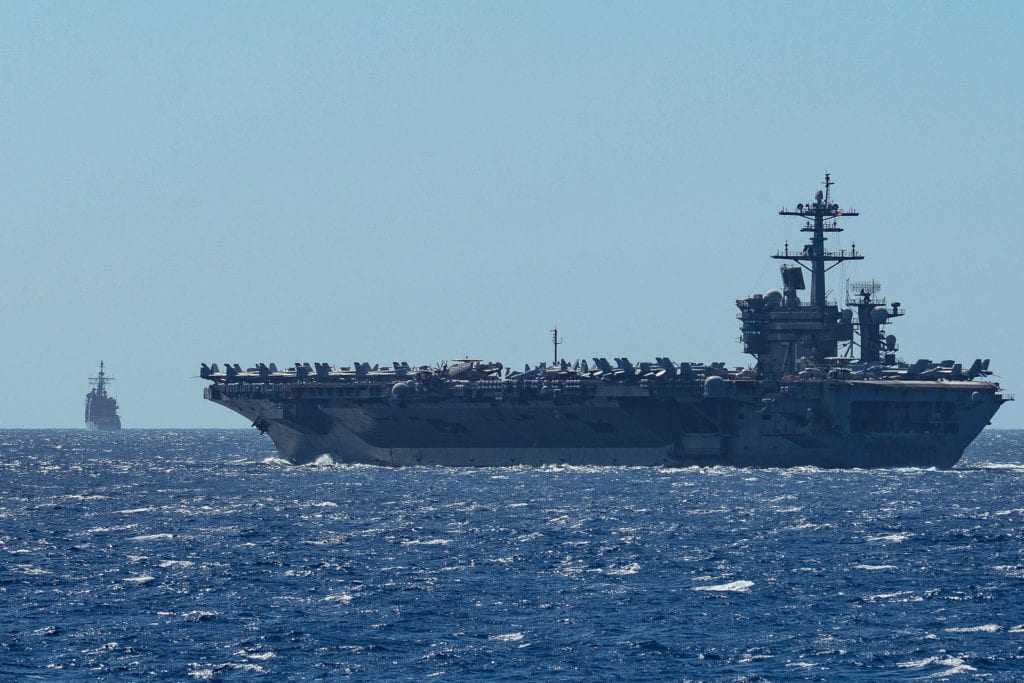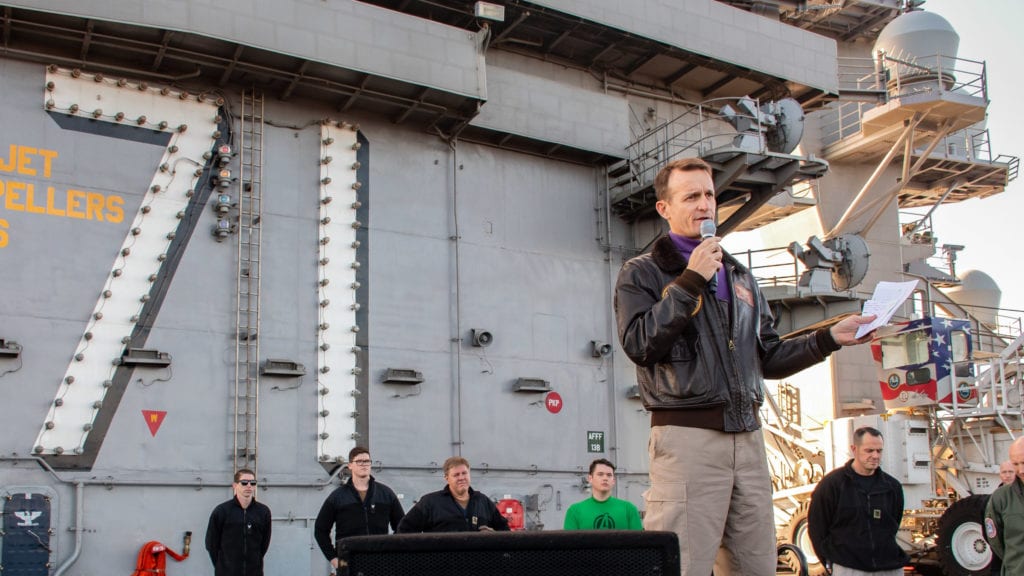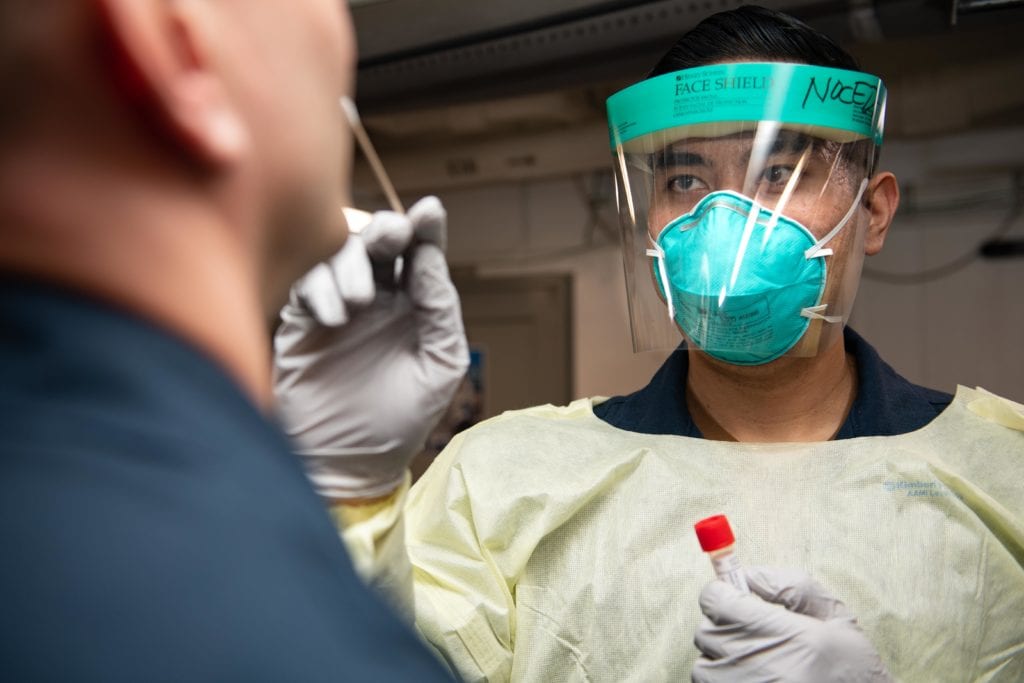
ARLINGTON, Va. — U.S. Navy officials are scrambling to find accommodations on Guam to isolate thousands of Sailors from the aircraft carrier USS Theodore Roosevelt, the first — and, so far, only — deployed Navy ship to be caught up in the coronavirus outbreak.
Meanwhile, media widely reported on April 2 that the Navy had dismissed the commanding officer of the carrier for speaking out about the Navy’s response to the outbreak aboard his ship.
Nearly 1,000 of the 4,865 Sailors that the Theodore Roosevelt got underway with in January are off the ship and being isolated on Guam, acting Navy Secretary Thomas Modly told a Pentagon press briefing on April 1. Officials hoped to have about 2,700 off the carrier in the next couple of days, he said. Less than 100 of the Sailors have tested positive for the novel coronavirus, COVID-19, and none have been hospitalized, Modly said.
See: Ship Construction Ongoing, Repairs Continuing Amid Outbreak
The entire ship’s company will not be evacuated all at once for security reasons, Modly stressed.
“We cannot and will not remove all the Sailors off the ship,” he said, adding that except for size, the 1,092-foot-long Roosevelt is not like a cruise ship. “The ship has weapons, munitions, expensive airplanes and a nuclear reactor,” he noted.
Chief of Naval Operations Adm. Mike Gilday said about 1,000 Sailors would be needed to handle maintenance and security as well as for cleaning and disinfecting the huge vessel. Gilday said healthy Sailors, after 14 days of quarantine, could rotate to the Roosevelt, replacing those still working on board.
The Navy is looking beyond its own properties and other Defense Department facilities on Guam to house Sailors taken off the ship for testing, isolation or quarantine. Modly said officials are working with Guam’s governor to free up hotel space there.
Once Sailors are tested they will either be isolated for 14 days if they test negative for COVID-19 or quarantined if they test positive for the virus, which has sickened 927,986 around the world and killed more than 46,000 people, including more than 4,700 in the United States.
As of April 1, 1,273 Roosevelt Sailors, about 24% of the crew, have been tested for COVID-19. Only 93 tested positive. Of those, 86 showed symptoms, while the other seven did not. Another 593 tested negative. Not all test results have returned, Modly said.
Officials said they still don’t know how the disease was brought on board. The Roosevelt’s last port of call — 15 days before the first three Sailors tested positive for COVID-19 — was Da Nang, Vietnam, in January when the World Health Organization reported only 16 cases in the country, all far to the north in Hanoi. Modly noted that aircrews were flying on and off the carrier and before it deployed most of the crew was on holiday leave. The ship also visited Guam in February. “Understanding exactly who patient zero is, is probably going to be an impossible task,” Gilday said.

“Let me emphasize that [Crozier’s letter] is exactly what we want from our officers and our medical teams. We need a lot of transparency in this situation, and we need that information to flow up through the chain of command.”
Acting Navy Secretary Thomas Modly
In a March 30 letter to Navy leadership, the carrier’s commander, Capt. Brett Crozier, said his ship had inadequate space to isolate or quarantine Sailors in keeping with guidance from the Centers for Disease Control and the Navy. “The spread of the disease is ongoing and accelerating,” Crozier wrote. He called for disembarking all but a token force of about 10% of the crew from the ship until all could be tested for infection, isolated for the required 14 days and the ship adequately cleaned.
The letter was leaked to the San Francisco Chronicle, which published it two days later, on March 31. The article, which gained wide media attention, included Crozier’s position that: “We are not at war. Sailors do not need to die. If we do not act now, we are failing to properly take care of our most trusted asset — our Sailors.”

Modly said the captain sent his letter through channels up the chain of command. The acting Navy secretary said that the special medical team that deployed with the Roosevelt is concerned about the same problem Crozier cited, not having enough space aboard for isolation measures, Modly said.
Citing Crozier’s letter, Modly said: “Let me emphasize that this is exactly what we want from our officers and our medical teams. We need a lot of transparency in this situation, and we need that information to flow up through the chain of command.” He said he didn’t know how the letter leaked to the San Francisco newspaper and probably never would.
- Shall We Play a Game? Winning Isn’t the Point, Experts Say - April 5, 2023
- U.S. Goal: Maintaining Extended Presence in Arctic’s Harsh Environment - April 4, 2023
- Joint, Combined Exercise Shows Marine Littoral Regiment Idea is on ”Right Track’ - February 24, 2023






